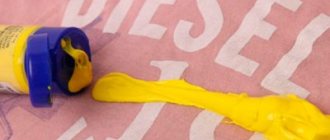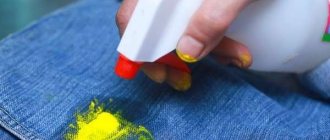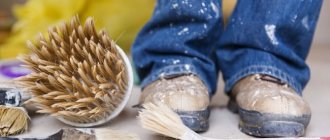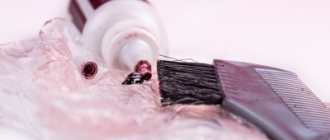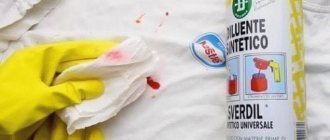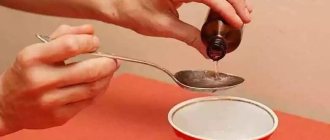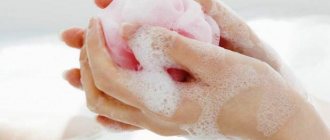There are many ways to get paint on your clothes. Most often children encounter stains. While walking on children's playgrounds, you may come across painted benches or swings. The highest chance of getting stained with paint is during renovation or painting. But you shouldn’t give up on contaminated things. In most cases, everything can be fixed, you just need to know how to remove paint from clothes.
General recommendations
Before removing paint from clothing, you need to know its type. Further cleaning will depend on this. In addition to the dye itself, the type of fabric and age of the stain will also affect the method.
A few tips for removing paint:
- The fresher the stain, the easier it is to deal with.
- Before treating the stain with your chosen product, place a few napkins under the stain to be on the safe side.
- To make sure the product is safe, test its effect on an inconspicuous area of fabric.
- To localize stains, scrub the stain from the edges to the center.
- Stain remover works well when washing, but before doing so, use the methods below.
- When finished, rinse the item and dry it in fresh air.
We will try to remove paint from clothes:
- stamp,
- acrylic,
- latex,
- water-based,
- oil,
- watercolor,
- gouache,
- tempera,
- printer ink,
- hair dye,
How to remove alkyd paint from clothes
In alkyd paints, the joining element is an alkyd resin. Alkyd paints can be diluted with drying oil, turpentine, and purified kerosene. Therefore, you can wipe off the paint:
- gasoline;
- white spirit;
- turpentine;
- kerosene.
A fresh stain of paint should be removed with a napkin. Then apply a little solvent to the fabric and rub the stain. Natural and eco leather are especially good at removing traces of paint.
Before scrubbing paint with aggressive solvents, you need to test the product on an inconspicuous place from the inside out or on a separate piece of fabric.
How to remove coloring compounds
First, let's find out how to remove paint from clothes and what needs to be done to do this. First of all, turn the item inside out and place a paper towel under the front side. Regarding what you can use to wash stains, we use the following products:
- Laundry soap. A partially forgotten legacy of the Soviet Union. For complex stains, apply toothpaste before using soap. Only after this is it treated with soap and cleaned with a brush.
- The solvent may not be used on all types of fabrics. But at the same time, it is an effective remedy that allows you to get rid of most stains. You can use purified gasoline or white spirit.
- Nail polish remover is powerful enough to remove most dyes.
- A solution of ammonia and gasoline will help remove paint stains at home.
- Vegetable oil is used to remove fresh stains; after finishing, the item is washed to remove any remaining oil.
There are many more means to remove paint from fabric, but these are the ones used most often.
Watercolor and gouache
Water-based paints are commonly used by children in art classes or by professional artists.
You can remove watercolor, tempera or gouache stains using laundry soap. If the dye has dried and soaked into the fabric, first soak the clothing in warm water or soapy water and leave for 30-60 minutes. When the dye begins to dissolve, wash the items and rinse well.
To remove stubborn stains, use a medium-hard brush. Direct the movement of the bristles from the edges to the center. Otherwise, the stain will only smear and increase in size.
To avoid damage when removing paint from delicate fabrics, use specially formulated stain removers. They are sold in household chemical stores.
To remove stains from glue-based gouache, prepare the following product. Mix glycerin, ammonia and technical alcohol in equal proportions. Soak the clothes in the solution for half an hour, then wash and rinse the item.
How to remove dried paint from clothes
The hardest thing to remove from clothes is dried paint. It is better not to let this happen, but sometimes you may not see the contamination in time. In such cases, the most serious and aggressive means are used. First, remove dried paint mechanically using a non-sharp object. Try not to damage the fabric while doing this. Buy purified gasoline and use a cotton pad to treat the stain. The procedure should dissolve the bulk of the dye. In the process, replace the contaminated cotton wool with new one. At the end, create a soda solution and treat the surface with a sponge. To remove residues and the smell of gasoline, wash the item.
How to remove water-based paint from clothes
The composition of water-based paint may contain resins that make it more resistant to water and detergents.
To remove it, use:
- alcohol;
- ammonia;
- vinegar;
- kerosene;
- turpentine and other chemical solvents.
Some types of water-based paint can be washed with soap and water or washing powder. Therefore, you should first try to wash the item this way. If that doesn't work, use more aggressive solvents.
How to Remove Oil Paint
Removing oil paint from clothes is quite difficult. Mechanical cleaning will not help here. This type of dye is amenable to solvents. You can use acetone or a liquid containing it for decorative varnish. The method is not suitable for colored items. It is enough to treat the contaminated surface, remove the residue after 10 minutes and wash.
How else can you remove oil paint from clothes? Take purified gasoline and lightly treat the stain. There shouldn't be a lot of funds. After a few minutes, rinse and put the item in the washing machine.
You can remove oil paint from clothes using turpentine. The principle of use and operation is the same as with gasoline. After finishing, the item is also washed. If there are stains from the product itself, they are treated with ammonia before washing.
For delicate fabrics it is better to use more gentle methods. Use the following recipe: melt the butter at room temperature, add the same amount of washing powder and stir until a homogeneous mixture is formed. Apply the resulting paste to the stain and gently brush with a toothbrush. After removing most of the paint, apply a little more mixture and leave for two hours. Now wash by hand using laundry soap and put it in the washing machine.
Particular attention is paid to removing paint stains from leather, wool, silk, viscose, and delicate synthetics.
⚠️ In the case of delicate fabrics, forget about aggressive solvents and brushes - they will simply ruin your blouse. Only gentle natural remedies. Do not wrinkle, stretch, twist, or actively rub such materials. Work from the wrong side with circular and “knocking out” movements.
From the above - laundry soap (rubbing, soaking), dishwashing gel, edible oil or fatty cream, fresh lemon (for light). Soda and lemon will not spoil delicate light-colored items. And here are some more methods that you can not be afraid to use to remove fresh and old paint stains from acrylic, printer or enamel.
Rub the stained spot on a leather jacket or woolen sweater with warm vegetable oil or cream, then rub gently with laundry soap and rinse with warm water.
Starch, mustard powder, salt, soda, white clay - all these are natural ingredients that are mixed with water and a thick mass is applied to the damaged area for a day to soften and remove pigment.
Heated glycerin can be used to soak fresh paint from any woven items or wipe it off a leather bag.
To make a gentle but effective paste, use refined gasoline with starch (or white clay). Apply it to the “patient” until it dries. Do as many times as necessary. In between cleaning sessions, rinse the area to monitor the effect of the product.
Turpentine will also not harm delicate fibers. Saturate the stained area, place cotton napkins underneath and on top and “pinch” the stain with your palms so that the dye transfers to the absorbent fabric. Change the fabric, add fresh turpentine. You can leave the cloth with dirt between two pieces of cling film for a couple of hours and continue removing until complete removal.
Oxygen stain removers for delicate fabrics know their stuff. Follow the instructions and you can easily remove even old yellow, red or white oil paint stains from wool and silk.
⚠️ There are recipes on the Internet with ammonia , but remember that like all alcohols, it can “eat” the color of the fabric, and it is also quite caustic, so use it in the case of delicate fabrics in a diluted form and with great caution. Dilute it with water 1:1 or even more and blot it with a cotton ball.
Denatured alcohol, vodka. First, the stain is moistened with warm water and thoroughly rubbed with laundry soap, and on top of the soap is treated with a sponge with denatured alcohol heated in a water bath. Use wet wipes to remove the remaining blots and wash. Warm alcohol is rubbed on the back of the blot, and then both the alcohol and the paint are washed out in a saline solution. Use with caution on colored items
If the product can withstand ironing. Moisten the stained part with water (or soak it in oil), sprinkle starch on top, apply absorbent paper napkins and iron. Change wipes often. Afterwards, wash the item at the maximum permissible temperature.
Curdled milk or kefir. Soak the stain for an hour or more in fermented milk product. The lactic acid they contain will carefully remove dirt without harming the fabric.
How to get rid of water-based and acrylic paint
Often there is a need to wash acrylic or water-based paint from clothes. It is used for painting benches and other objects in public places. Anyone can find it on clothes. Alcohol will help get rid of this type of paint. Stretch the fabric and rub with a cotton pad soaked in alcohol.
Sometimes washing with washing powder helps to wash off water-based paint. In this case, first with cold and then with hot water. Consider the maximum permissible temperatures for your fabric type.
There is another way to remove acrylic paint from trousers and other clothes. Use the following recipe: mix vinegar, ammonia and salt in a ratio of 2:2:1. Mix thoroughly and apply to stains; after a few minutes, scrub off with a brush. Residues are washed by hand with powder or laundry soap.
Trouble at work - we wash away stains from the printer and stamps “without leaving the machine.”
- ✑ As soon as paint from a cartridge or stamp gets onto a blouse, skirt or jacket, take wet wipes for your hands or a cotton rag and run to the ladies'/men's room.
- ✑ Use only cold water, hot water can only make things worse.
- ✑ It’s good if you can remove clothes and wash them in a horizontal position. If you are wearing clothes, place a cotton rag under the back of the stain, blot the stamp blot with another piece of cotton, changing the “blotter” and trying to remove as much of the dye as possible.
- ✑ Then apply a little liquid hand soap , lightly rub in the center of the stains and blot again with clean wet wipes . You may not be able to complete it in an office setting, but it will make your work much easier when you return home.
- ✑ By the way, for a white shirt, you can ask the cleaning lady for a little bit of any chlorine-containing product . ⚠️Do not let the substance touch your skin and do not keep it on your clothes for a long time so as not to spoil it. Apply it, wait a minute and wash it off.
- ✑ Well, at home, already use the folk methods described just above - for acrylic and gouache paints)
Py.Sy. a spare set of clothes at work , then removing a print stain right at work will be much easier. By the way, if you suddenly get stained with ink from a pen, here are some other ways to save your work suit.
Clean clothes from hair dye
Due to their poor financial condition, women often resort to dyeing their hair at home. People are turning less and less to hairdressers and hairdressers. During the dyeing process, unexpected stains may arise that make you wonder how to remove hair dye from clothes. This type is especially durable because it must remain on the hair even when washed with shampoo or other detergents. You need to act as quickly as possible. You can get rid of fresh stains using regular hairspray or washing.
The most difficult thing to remove is an old stain on clothing. Try using hydrogen peroxide, but it can discolor fabrics, so it's only suitable for white items. Treat the stain and leave for half an hour. Rinse off the residue and throw the item in the wash.
Synthetics and wool are best cleaned with vinegar. If an item contains henna, it requires a special approach. You will need a solution of hydrogen peroxide, ammonia and water. Mix thoroughly, treat the stain and leave for a few minutes. All that remains is to wipe off the residue and wash it.
How to remove paint from a carpet, chair or sofa
- You can’t put a carpet or sofa in the washing machine (Captain Obvious!), so use products to a minimum.
- Be careful not to smear the paint.
- Stock up on “blotters” - you will need a lot of them.
- Pay attention to the color and composition of the material and choose the most suitable method from those listed in the article. Do not use hot water - only cool water , otherwise the paint will “go” deeper.
- Do not dry the carpet or chair with a hairdryer - you can ruin the thing forever.
- If you understand that the disaster is large-scale and you cannot cope with it yourself, contact a company that cleans carpets professionally. For them, removing difficult stains is a daily routine.
How to remove ink from a printer
Having a printer at home, sooner or later paint contamination from it occurs. This could be during refills, home repairs, or the device simply malfunctioned and released too much ink onto the paper. In any case, action must be taken urgently. It is advisable to immediately soak in cold water, or better yet, wash in it. Ideally, hand wash in cold water using laundry soap. To remove old paint, treat with hydrogen peroxide for 10 minutes before washing.
Can I remove it myself?
You can remove paint stains from clothes if you do it correctly.
The complexity of the work is due to a number of factors, including:
Duration of stay of the stain on clothing. The faster measures are taken to remove it, the easier it is to deal with the stain.- Type of dye. The hardest thing is to get rid of persistent compounds (hair and eyelash dye, construction paints). Art and food dyes are easier to remove.
- Degree of pollution. The larger the stain, the more difficult the work to remove it.
The type of matter matters. Paint penetrates faster and deeper into fibrous fabrics than into a smooth surface. The task becomes more difficult if the stain was applied to delicate fabrics.
When can you handle it yourself, and when should you turn to professionals for help?
Before you begin processing, you need to pay attention to the following points:
- It is almost impossible to get rid of construction paints (water-based, acrylic, oil) on your own. Sometimes it is not possible to remove them even in professional dry cleaners.
- The best stains to remove are from thick fabrics, such as jeans.
- You can deal with the stain yourself if no more than 2-3 days have passed since the paint got on your clothes. Later, it will be difficult to remove it at home.
If even the professionals couldn’t get rid of the paint, but you want to preserve the item, you can use decorative techniques. Stains are masked with rhinestones, stickers, stripes and other elements.
Removing other stains
It is not uncommon to need to clean other types of paint. It is worth considering separately for children: gouache and watercolor. They are water-based, so fresh stains can be removed with regular washing. Large stains may not be washed off completely, leaving their mark on the entire surface of the clothing. Such contaminants are first washed by hand under waste water, after which they are also sent to the washing machine.
Enamel products are susceptible to solvents. Soak a cotton pad in it, squeeze out the excess and start wiping off the dye. As the color changes to the cotton wool, replace it with a new one.
The easiest way to deal with stains on leather products. Very fresh marks can be wiped off with regular wet wipes. More complex ones with vegetable oil or laundry soap. Rub the selected product onto the stain, wipe with a dry soft cloth and remove any residue with a damp, clean cloth.
Delicate fabrics require a unique approach. Heat ammonia to a temperature of 40-50 degrees, lightly moisten a cotton swab and wipe gently. Replace the tampon as needed and continue cleaning until completely clean. Finally, pour warm water into the basin, add enough salt to form a weak saline solution. Rinse the item in it.
If it is difficult to determine the type of paint, use a universal laundry soap. Rub the contaminated surface thoroughly and leave for 1-2 hours. Wipe with cotton and rinse.
How to remove an old paint stain from a leather item
To remove paint from a leather jacket, you can use vegetable oil. You can mix vegetable oil with leather cleanser.
A cotton pad or piece of cloth should be soaked in the oil mixture and the paint should be wiped off. When the paint is wiped off, you need to remove the oil with a napkin and apply a skin care product. If the paint stain on the jacket is fresh enough, you can wash it with dishwashing detergent:
- beat the product with water;
- rub the stain;
- remove residues with a damp cloth;
- treat with leather product.
Useful tips
When it becomes necessary to manually remove paint from clothing, first of all, you need to think about the degree of protection of the skin. We are talking about rubber gloves. This way you will protect your hands from chemicals and from dryness when washing.
Before using any drug, test its effect on an invisible area of tissue. If there are no negative consequences, you can continue cleaning.
The stain remover works great for this type of stain. If pollution is an everyday thing for you, it is advisable to buy the product and use it on an ongoing basis.
How to remove stains using household chemicals?
To get rid of paint, you can use specialized compounds that are sold in stores. Universal stain removers can cope with even stubborn stains.
When choosing a suitable product, you need to pay attention to the following points:
Presence of chlorine. This is an effective component, but it can harm delicate fabrics. If the stain remover contains chlorine, it is recommended to use it only for white items and only in emergency cases.- Amount of surfactant. They help remove paint, but their content in the chosen product should not be high so as not to damage the item.
- Liquid bleaches are easy to use because they do not require pre-soaking the item.
- If the stain remover contains enzymes and active oxygen, its cleaning properties increase.
When purchasing, you need to read the label. It should indicate for which items a particular detergent is suitable.
General rules of use for all stain removers:
- apply the product to the contaminated area;
- leave to have an impact;
- wash the item as usual.
To increase washing efficiency, a stain remover can be added to the selected product.
Top 3 effective stain removers
To remove dried paint from fabric, you can use one of the following products:
Vanish Oxi Action Gold Gel .
For best results, the stain must be soaked. Colored items are left to act for 60 minutes, and white items for 3-4 hours. Then the product must be washed with the addition of Vanish. The gel is suitable for the care of delicate fabrics. The cost of a 450 ml bottle is 250-300 rubles.- Udalix Oxi Ultra .
To get rid of paint, you need to soak the item in hot water (at a temperature of 60 degrees) for an hour. It is then washed according to the instructions on the label. The cost of an 80 g package of powder is about 30 rubles. This is an effective and budget-friendly product, but it is not suitable for washing delicate items, as it does not work at low temperatures. - Sarma Active . This is an inexpensive powder stain remover that contains enzymes. It can be used for washing at low temperatures (the minimum value for activating the detergent is 30 degrees). To achieve the optimal effect, it is recommended to soak the stained item for 3-4 hours. The cost of a package weighing 0.8 kg is 120 rubles.
When choosing a stain remover, you need to read the information on the product label. Some fabrics do not tolerate contact with aggressive detergents.
Adviсe
Recommendations for removing dried paint:
Paint-stained items should be washed separately from other clothes.- To increase washing efficiency, the fabric needs to be soaked.
- When working with aggressive agents, gloves should be used.
- You need to wash the stain as quickly as possible, even if it has already dried.
- To get rid of gouache and watercolor paints, regular washing using a simple powder is enough.
If paint is removed from fabric with cotton wool, it should be changed as often as possible so as not to smear the pigment onto clean fibers.
Removing dirt from clothes
According to the degree of fabric contamination, stains are divided into two types:
- easily removable;
- difficult to remove.
If you are going to remove oil stains from things that have been sitting for several months after repair, this is useless. It is better to throw away such clothes immediately.
It is also impossible to wash clothes without additional detergents: the paint seems to “bite” into the structure of the fabric, filling the free space.
The following are used as detergents or cleansers:
- laundry soap;
- turpentine;
- solvents for certain types of coatings;
- alcohol, acetone or gasoline;
- folk remedies.
the washing up
If you planted a stain just a few minutes ago, it needs to be removed quickly. A completely fresh, still damp oil paint stain can be easily washed off with laundry soap. It's not toxic enough to ruin fabric, but it's best to be careful: If you're concerned about the effects of harsh soap on your hands, it's best to play it safe and wear gloves.
You may notice that your attempts to clean the stain are becoming successful right now. It will fade and the clothes will become clean. But if this doesn't happen, don't despair. It is still possible to wash the item.
If the drop has not yet dried, to clean the clothes, just wash the stain and rinse several times in running water. After this, it is advisable to wash your work clothes in a washing machine, but this is not necessary if the initial goal was only to get rid of the oil paint stain.
Cleaning
If the paint is dry, scrape the stain with a knife. This will help remove the layer without ruining the item. If you manage to completely get rid of the stain, all that remains is to wash the item to completely remove the dirt. If not, you will have to use solvents or other chemicals.
This works especially well with denim. It itself is hard, and there is nothing for paint, even oil paint, to “catch onto.” Therefore, dried stains will be easily removed from jeans and denim jackets.
Traditional solvents
If several days have passed after the stains appeared on the clothes, then it’s time for the “heavy artillery.” To help remove stains from fabric:
- petrol;
- kerosene;
- turpentine.
When using them, you should not let your guard down. When working with such substances, you should wear gloves and stay away from gas or fire if they are present nearby. Before you begin removing the stain, check how the fabric reacts to treatment with gasoline or turpentine. If there is no aggressive reaction, you can begin cleansing.
Place a rag or gauze on the wrong side opposite the stained area, soak another rag in kerosene or gasoline and begin removing. Using light but sharp movements, try to “remove” the stain, but do not rub it even more. Most likely, there will be stains on the fabric. You can get rid of them by washing your clothes or treating them with alcohol or dishwashing detergent.
This type of treatment can easily ruin the fabric. Therefore, if you accidentally stain something made from delicate fabric, such as a light silk blouse or dress, it is best to take it to the dry cleaner. You are unlikely to be able to remove the paint on your own. Professionals will do a better job of this, and you will get a clean item back.
If the dry cleaner cannot remove the oil paint stain, the clothes can definitely be considered lost.
Butter
Among the ways to provide “first aid” to soiled clothes, there is one strange method. To remove an oil stain, coat it with a thick layer of butter and leave for an hour and a half. Then the oil is removed with a sponge soaked in alcohol, and the clothes are washed in warm water. The main thing is to wait until the paint softens so that it can be washed off. This requires an hour of waiting.
To enhance the effect, butter is mixed with washing powder or even several, and then this mixture is applied to the stain. You should also be careful with this method, because the butter may leave streaks on the fabric. If this happens, the clothes will have to be washed several times.
Special solvents
To clean paint, you can buy solvents at hardware stores that are designed specifically for certain types of paints. They are cheap and can help you remove oil stains.
As can be seen from the description of methods for cleaning clothes, this will take some time and money, and can even be dangerous. Therefore, if you do not feel the need to clean these clothes, it is better to replace them.
If you often encounter the need to work with oily coatings in connection with repairs or finishing work, get special work clothes that you don’t mind getting ruined. It is undesirable to be near paints or other substances that could ruin an expensive item. Therefore, it is better to wear work clothes during repair or construction work. Then you won’t have to remove stains using methods that are hazardous to your health.
Thinner for paints and drying oils
Solvents are used for thickened and dried paint and will help remove it by liquefying it.
Depending on the type of paint, solvents are also used; there are several subtypes of coloring materials:
- paints intended for household needs, that is, needed for application to the surfaces of buildings or objects
- used for art, that is, those used to draw.
So, to transform the coloring material into a more liquid state, you can use the following types of solvent:
- turpentine;
- White Spirit;
- drying oil oxol;
- gasoline or kerosene and many others.
If you are going to clean paint from a fabric surface, linseed oil drying oil is a good choice, as it is quite easy to remove from the material.
Removing stains from fabric surfaces is a procedure that requires care to avoid damaging it. You should also determine the type of paint stain, this will help you choose the right method and means for removal.
Use a mixture of butter and powder
We take washing powder or liquid detergent - which is usually used for washing this item. Mix in equal proportions with butter, mix thoroughly . Spread the resulting mixture onto the stain, spread it well, trying to rub it in. Leave for about a quarter of an hour. Rinse with water and wash as usual.
